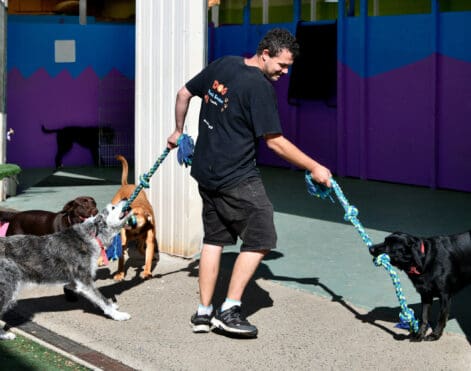Finding the Perfect Fit
Before you purchase your collar, you need to take some accurate measurements to ensure that it’s suited for your dog. All dogs are different. Even two dogs of the same breed can have different neck measurements due to lifestyle and weight.
Instead of guessing, whip out a tape measure and figure how large your dog’s neck is.
To do this, simply wrap a cloth tape measure around their neck. It’s a good idea to take a few different measurements at various points on their neck. If you don’t have a cloth tape measure, you can also use a piece of string or fabric and measure that with a standard ruler.
In addition to measuring the circumference of your dog’s neck, you need to consider the thickness. Some breeds, such as Pugs and Bulldogs, have relatively short necks that require thinner collars. If the collar is too thick, it could cause uncomfortable chaffing as your pup walks.

There’s no way to measure for width. Just examine your dog and see if they would fair better with a shorter or thicker collar. Generally, thinner collars are more comfortable for small or overweight dogs.
Collars come in a range of sizes to suit all breeds. Many manufacturers use sizing labels like “Small,” “Medium,” and “Large.” Don’t take these sizes at face value. Like with human clothing, collar sizes can vary from brand to brand. However, for your dog’s comfort and safety, the most important aspect when selecting your dog’s collar is to ensure that the collar fits correctly.
It’s a fine line between making it too loose and too snug. The collar needs to be tight enough to prevent your dog from wriggling their way out, yet loose enough to not cause injuries. While most people don’t give their dog’s collar a second thought, these accessories can be dangerous.
Injuries from an improperly fitted collar are more common than you think.

The Two-Finger Trick
Once you have the collar, you can put it on your dog and perform the “Two-Finger” test. Secure the collar around your dog’s neck so that it has enough room to move around, but should be secure in place, high up on neck, not low near the shoulders and should not be able to move up and down. It should not, by any means, be pressing into your dog’s skin.
Then, slide two fingers behind the collar and against your pup’s neck. If the collar feels snug, it’s just right. You shouldn’t have to force your fingers underneath the collar. If it’s difficult to perform this test, the collar is too tight.
Also, it’s recommended that you slide the collar up to see if it can slip over your dog’s head. Canines with triangular heads, such as a Siberian Husky or Greyhound, are notorious for slipping out of their collars at the most inopportune times. If the collar can make it past the ears, it needs to be tightened a bit.
After you have found the proper-size collar for your dog, remember to check periodically to ensure your dog’s collar is in good repair and still fits correctly.
At Big Brown Paws, our two favourite picks for collars for training and for general use with our own dogs are the Flat collar and slip lead. We use these at day-care on a daily basis.
The slip lead – this simple, one-piece collar and leash has a loop on one end for your hand and on the other end, a ring with the rope fed through making a loop to place over the dog’s head. On the dog’s end, there is also a leather stopper that keeps the collar from loosening. This tool is used around the world from dog trainers and breed show dogs. Great way to help your dog learn to walk on the lead.



The Flat collar – These are usually made of fabric or leather and have a metal buckle to fasten them around the dogs neck. They look a lot like a small belt. There are the plastic snap ones but these are not recommended, as they can loosen on their own and easily break or be chewed. Remember the rules above apply. You also need to make sure there isn’t a lot of etc collar hanging out after the buckle, this means the collar is too big. If you have a dog that their head and neck are the same size this type of collar may not work, as you will be able to slip over head if this is so we recommend the slip lead why’ll walking.
Pet parents should exercise caution in leaving a collar on a dog when they are relaxing or playing at home. As a dog moves around the house or yard, a collar can get caught on any number of things. In extreme cases, this can cause strangulation.
These collars are not recommended due to them being unsafe, harmful and dangerous.


Below are to great clips on fitting a collar and walking with a slip lead.
In this video, Steve is going to show you how to fit a dog collar for leash walking training.
https://www.facebook.com/cesar.millan/videos/3943818395697709
In this episode, Cesar teaches





